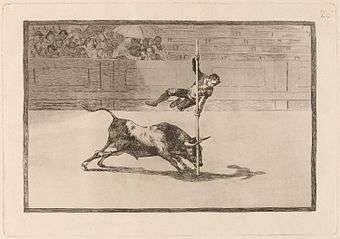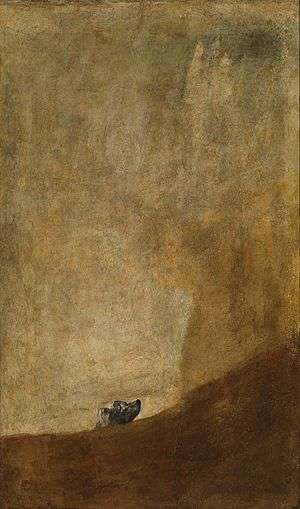Unfortunate Events in the Front Seats of the Ring of Madrid, and the Death of the Mayor of Torrejón

Unfortunate events in the front seats of the ring of Madrid, and the death of the Mayor of Torrejón (or Fatal mishap in the stands...) (or The Speed of Daring of Juanito Apiñani in the Ring of Madrid)[2] (Spanish: Desgracias acaecidas en el tendido de la plaza de Madrid, y muerte del alcalde de Torrejón) is an etching with burnished aquatint, drypoint and burin on paper by the Spanish painter and printmaker Francisco Goya.
Unfortunate events is one in a series of 35 etchings making up his Tauromaquia ("Art of Bullfighting") series, which he produced between 1815 and 1816.[3][4] The plate has been described by Robert Hughes as among the greatest of Goya's graphic output.[5]
Throughout his life, Goya was a keen follower of bullfighting and boasted that he had taken on a bull in his youth.
Description

Etching and aquatint
The etching details an event from 15 June 1801 when a bull broke through barriers at a bullfight in Madrid, killing two people (including the mayor of Torrejón de Ardoz)[6] and injuring a number of other spectators. The lifeless body of the mayor is seen impaled and hanging from the triumphant-looking animal's horns,[7] while the second dead man is shown beneath the barrier in the middle-ground, mourned by a woman in white.
The action takes place entirely on the lower right side of the print, which is separated from the left and upper areas by rail and skyline. These areas are almost completely empty and devoid of detail; the composition rebels against traditional artistic conventions regarding balance and harmony.[8] Three of the etching's quarters are completely still; the activity is contained entirely in the right foreground, where a jumbled and blurred mass of survivors are running left and right in panic to escape.[8] None have crossed the handrail; the corpse of one victim lies straddled beneath the barrier, between the two halves of the page.
Empty space

Goya's use of empty space has been described as an indication of how his work, of all the Old Masters, is closest to the spirit of Modernism. He was to use areas of empty space for dramatic and evocative effect again in his "Black Paintings", notably in The Dog and The Great He-Goat.[8] Hughes, writing on how Goya anticipates a number of the later ideas of European art, remarked in 2004 of the "naked power with which Goya has played off void against solid, black against light, empty space against full."[2] The picture rewards detailed examination, in that much of the subtleties are not at first obvious. For example, the late mayor's shoe can be seen in the distance protruding from the bull's neck, making the man all the more pathetic a figure against the force and strength of the animal.[2]
Notes
- ↑ Print sizes vary by 1 or 2 cm
- 1 2 3 Hughes, 360
- ↑ Hagen & Hagen, 84
- ↑ During he same period, he was completing his The Disasters of War engravings
- ↑ Hughes, 365
- ↑ "Dreadful events in the front rows of the ring at Madrid and the death of the mayor of Torrejón, Plate 21 of La Tauromaquia". National Galleries of Scotland. Retrieved on 25 February 2010.
- ↑ Regan, Margaret. "Telling Moments: The first in a series of Francisco de Goya etchings arrives at the UA Museum of Art". Tucson Weekly, 26 April 2007. Retrieved on 25 February 2010.
- 1 2 3 Hagen & Hagen, 89
Sources
- Hagen, Rose-Marie & Hagen, Rainer. Francisco Goya, 1746–1828. Taschen, 2003. ISBN 3-8228-1823-2
- Hughes, Robert. Goya. New York: Alfred A. Knopf, 2004. ISBN 0-394-58028-1
